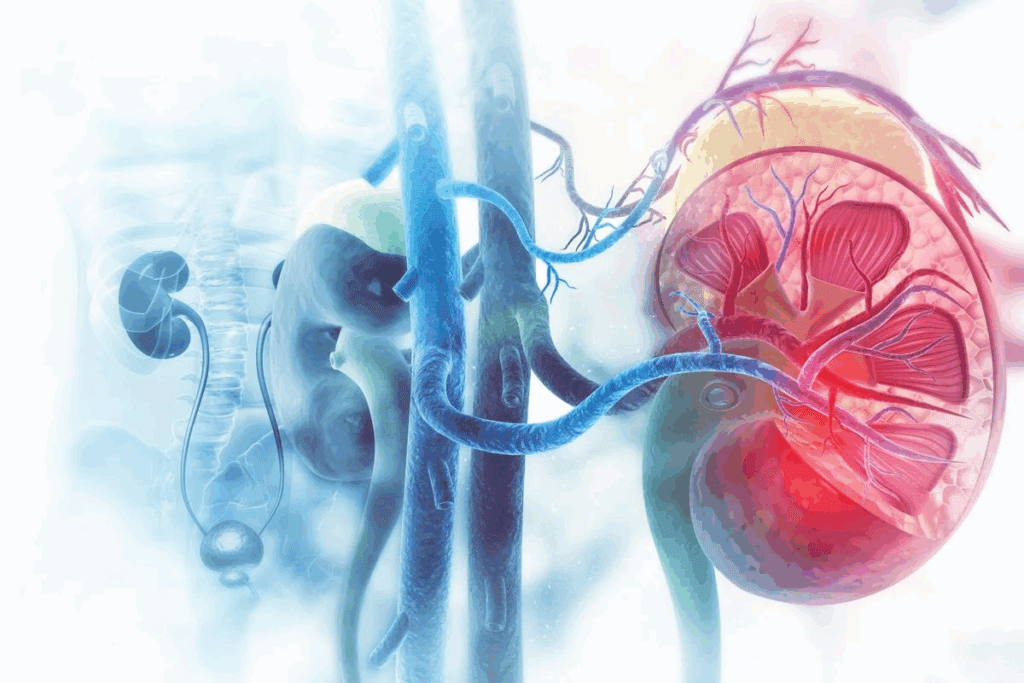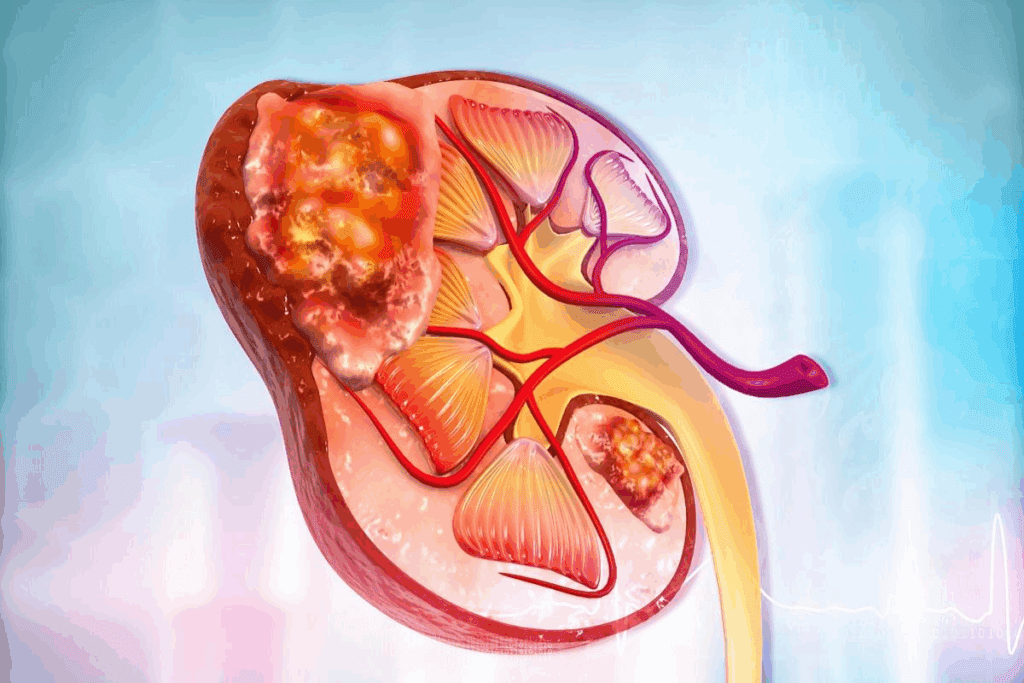Last Updated on November 26, 2025 by Bilal Hasdemir

Renal cell carcinoma (RCC) is the most common kidney cancer. It’s a complex challenge with many treatment approaches. These are based on tumor characteristics and patient factors. Explore 7 effective kidney tumor treatment options. Our guide covers the latest therapies for RCC, from surgery to ablation.
When kidney cells grow out of control, kidney cancer develops. Symptoms include flank pain, high blood pressure, and blood in urine.
At Liv Hospital, we offer top-notch care for RCC patients. We use the latest RCC therapies, like immunotherapy and targeted drugs. Our aim is to help patients make informed choices about their care.
Key Takeaways
- Understanding renal cell carcinoma (RCC) and its treatment options
- The importance of tumor characteristics and patient factors in determining treatment approaches
- The role of immunotherapy and targeted drugs in RCC treatment
- Comprehensive care for patients with RCC at Liv Hospital
- The latest advancements in kidney tumor treatment
Understanding Kidney Tumors and Renal Cell Carcinoma

It’s important to know about kidney tumors to plan the best treatment. Most kidney cancers are renal cell carcinoma. These tumors can be harmless or cancerous.
Types and Stages of Kidney Tumors
Kidney tumors are divided by their type and how they grow. Renal cell carcinoma starts in the kidney’s lining. It’s the most common kidney cancer in adults.
The cancer’s stage is key for treatment. For small tumors, surgery is often the best choice. This helps keep the kidney working well.
Risk Factors and Prevalence
Several things can increase your risk of renal cell carcinoma. These include smoking, being overweight, high blood pressure, and some genetic conditions. Knowing these risks helps prevent and catch cancer early.
Men are more likely to get this cancer than women. It usually happens to people between 50 and 70 years old.
How Treatment Approaches Vary by Stage
Treatment for kidney cancer changes with the disease’s stage. Early stages (1 and 2) often get surgery. But, more advanced stages (3 and 4) might need other treatments like targeted therapy or immunotherapy.
Treatment plans are made just for you. They consider your health, the tumor’s details, and the cancer’s stage. We’ll look at these options in more detail later.
Factors That Determine the Best Kidney Tumor Treatment Options

Finding the right treatment for kidney tumors is complex. It depends on how well the tumor is diagnosed, the patient’s health, and teamwork in care. When a kidney tumor is found, doctors do a detailed check to decide the best treatment.
Diagnostic Process and Staging
The first step in diagnosing kidney tumors is a detailed medical history and physical check. Tests like CT scans, MRI, and ultrasound help find the tumor’s size, where it is, and if it has spread. A biopsy might be needed to confirm the tumor type.
Accurate staging is critical for knowing how far the disease has spread. This helps doctors choose the right treatment. They look at if the tumor is just in the kidney or has spread to other places.
Patient-Specific Considerations
Every patient’s situation is unique when it comes to treatment. Doctors consider the patient’s health, how well the kidneys are working, and any other health issues. They also think about what the patient wants and values to make sure the treatment fits their needs.
For example, patients with advanced kidney cancer might get treatments like immunotherapy or targeted therapy. Immunotherapy options include PD-1/PD-L1 and CTLA-4 inhibitors. Targeted therapies might be tyrosine kinase inhibitors or anti-VEGF agents.
| Treatment Approach | Description | Patient Profile |
| Surgical Intervention | Removal of the tumor or kidney | Localized tumors, good kidney function |
| Immunotherapy | Stimulating the immune system to fight cancer | Advanced or metastatic RCC |
| Targeted Therapy | Targeting specific cancer cell mechanisms | Advanced RCC, specific genetic mutations |
The Multidisciplinary Approach to Treatment Planning
A team of doctors is key in planning treatment for kidney tumors. This team includes urologists, medical oncologists, and others. They discuss the patient’s case and decide the best treatment together.
This team approach makes sure all parts of the patient’s care are covered. From the start to follow-up, the team works together. This way, they can give care that meets each patient’s unique needs.
1. Surgical Interventions: The Gold Standard for Localized Tumors
For those with localized kidney tumors, surgery is the top choice. We use different surgical methods to remove the tumor. This way, we keep as much of the healthy kidney as we can.
Partial Nephrectomy: Preserving Kidney Function
Partial nephrectomy, or kidney-sparing surgery, removes the tumor but keeps the healthy part. It’s great for smaller tumors or those with only one kidney.
The benefits of partial nephrectomy include:
- Preservation of kidney function
- Reduced risk of chronic kidney disease
- Lower likelihood of cardiovascular events
Radical Nephrectomy: When Complete Removal is Necessary
Radical nephrectomy removes the whole kidney and nearby tissues. It’s often needed for bigger tumors or when cancer has spread.
This surgery is more invasive. But, it’s sometimes the only way to remove all cancer. New surgical methods have made this procedure safer for patients.
Minimally Invasive Surgical Approaches
Minimally invasive surgeries, like laparoscopic and robotic-assisted, have big advantages. They use smaller cuts, cause less pain, and lead to quicker recovery.
- Smaller incisions
- Less postoperative pain
- Shorter hospital stays
- Faster recovery times
Recovery and Long-term Outcomes
Recovery and long-term results depend on the surgery type and patient health. Patients are watched closely for any issues or cancer coming back.
Research shows surgery greatly improves survival for localized kidney tumor patients. The right surgery is chosen based on the patient’s health and condition.
2. Targeted Therapy: Precision Medications for RCC
Targeted therapy has changed how we treat renal cell carcinoma (RCC). It uses precise medications that target specific molecular pathways. This has greatly improved outcomes for patients with advanced or metastatic disease.
Tyrosine Kinase Inhibitors (TKIs)
Tyrosine kinase inhibitors (TKIs) are a key part of RCC treatment. They block tyrosine kinases, enzymes that help tumors grow and make new blood vessels.
Sorafenib was the first TKI approved for RCC. Later, sunitinib and pazopanib were developed. These drugs have shown better results in patients with metastatic RCC.
Anti-VEGF Agents
Anti-vascular endothelial growth factor (anti-VEGF) agents are also used in RCC treatment. VEGF is a protein that helps tumors make new blood vessels.
Bevacizumab is an anti-VEGF monoclonal antibody. It works with interferon-alpha to slow tumor growth by blocking VEGF.
mTOR Inhibitors
The mammalian target of rapamycin (mTOR) is important for cell growth and survival. mTOR inhibitors, like everolimus and temsirolimus, target this pathway to fight tumors.
These medications are effective in treating RCC, even after other treatments have failed. They can slow disease progression and improve survival.
Side Effect Management and Monitoring
Targeted therapies have improved RCC treatment, but they can cause side effects. Common side effects include fatigue, diarrhea, high blood pressure, and skin rash.
Managing these side effects is key to keeping patients’ quality of life high. Regular monitoring and adjusting doses can help reduce toxicity and improve treatment results.
To show the different targeted therapies for RCC, here’s a table summarizing the main classes:
| Class | Examples | Mechanism of Action | Common Side Effects |
| Tyrosine Kinase Inhibitors (TKIs) | Sorafenib, Sunitinib, Pazopanib | Inhibit multiple tyrosine kinases involved in tumor growth and angiogenesis | Fatigue, Diarrhea, Hypertension, Hand-foot syndrome |
| Anti-VEGF Agents | Bevacizumab | Inhibit vascular endothelial growth factor (VEGF) to reduce angiogenesis | Hypertension, Proteinuria, Bleeding, Thromboembolic events |
| mTOR Inhibitors | Everolimus, Temsirolimus | Inhibit the mTOR pathway to regulate cell growth and survival | Stomatitis, Rash, Fatigue, Hyperlipidemia |
3. Immunotherapy: Harnessing the Body’s Defenses Against RCC
Immunotherapy is changing how we treat RCC by boosting the body’s fight against cancer cells. It’s a big help for those with advanced or metastatic renal cell carcinoma. This gives new hope to patients with few treatment choices.
Immunotherapy uses the body’s immune system to attack cancer. It uses medicines that make the immune system better at finding and killing cancer cells. For RCC, different types of immunotherapy have been made. These include checkpoint inhibitors that target specific proteins on immune cells or cancer cells.
PD-1/PD-L1 Inhibitors
PD-1/PD-L1 inhibitors are a type of checkpoint inhibitor that work well against advanced RCC. They block the PD-1 protein on T cells and the PD-L1 protein on cancer cells. This lets T cells keep attacking cancer cells.
Nivolumab and pembrolizumab are common PD-1/PD-L1 inhibitors for RCC. Studies show they can improve survival and response rates in patients with advanced RCC.
CTLA-4 Inhibitors
CTLA-4 inhibitors are another type of checkpoint inhibitor for RCC. They block the CTLA-4 protein on T cells, boosting the immune response against cancer. Ipilimumab is a CTLA-4 inhibitor used with other immunotherapies for RCC.
Combination Immunotherapy Approaches
Using different immunotherapy agents together is a promising strategy for RCC. For example, combining a PD-1 inhibitor with a CTLA-4 inhibitor can improve response rates and survival.
| Combination Therapy | Agents Used | Clinical Benefit |
| PD-1 + CTLA-4 Inhibition | Nivolumab + Ipilimumab | Improved overall survival and response rates |
| PD-1 Inhibition + TKI | Pembrolizumab + Axitinib | Enhanced progression-free survival |
Predicting Response to Immunotherapy
Immunotherapy has helped many with RCC, but not everyone responds. Scientists are working to find biomarkers to predict who will benefit most.
They’re looking at tumor mutational burden, PD-L1 expression, and immune cells in the tumor microenvironment. These could help predict who will respond to immunotherapy.
4. Ablation Techniques for Small Renal Tumors
Ablation techniques are a new way to treat small renal tumors. They are less invasive than traditional surgery. These methods destroy tumor cells directly, making them a good option for some patients.
Radiofrequency Ablation (RFA)
Radiofrequency Ablation (RFA) is a common method for treating small renal tumors. A special needle is inserted into the tumor under imaging. It sends high-frequency electrical currents that heat up and kill the tumor cells. RFA is precise and helps keep healthy kidney tissue safe.
Cryoablation
Cryoablation, or cryotherapy, freezes tumor cells. A cryoprobe is inserted through the skin and guided to the tumor. The cold temperatures kill the tumor cells, making it a targeted treatment with little damage to nearby tissues.
Microwave Ablation
Microwave Ablation uses microwave energy to heat and destroy tumor cells. Like RFA, it involves inserting a microwave antenna into the tumor. It can heat up faster and might work for larger tumors or when RFA is not an option.
Ideal Candidates and Success Rates
The success of ablation techniques depends on several factors. These include tumor size, location, and the patient’s health. Ideal candidates are those with small tumors (less than 3 cm) and those who can’t have surgery. Studies show good results, with high success rates and few complications. But, it’s important to follow up long-term to check for any recurrence.
5. Stereotactic Body Radiotherapy (SBRT) for Kidney Cancer
Stereotactic body radiotherapy (SBRT) is a top choice for treating kidney cancer. It precisely targets tumors with little harm to healthy tissue. This method is great for those who can’t have surgery or other treatments.
How SBRT Works for Kidney Tumors
SBRT uses cutting-edge imaging and radiation tech to hit kidney tumors with precision. It sends high doses of radiation right to the tumor, protecting nearby healthy tissue. The treatment is spread over several sessions, aiming for effective tumor control with fewer side effects.
Proton Therapy Advantages
Proton therapy is a form of SBRT that uses protons to kill cancer cells. It’s better because it causes less damage to healthy tissue and lowers the chance of secondary cancers. It’s a good choice for tumors close to important areas, as it delivers radiation more accurately.
Treatment Planning and Delivery
SBRT needs careful planning and delivery. It uses CT and MRI scans to map the tumor and healthy tissue. The radiation oncologist then crafts a treatment plan based on the tumor’s size, location, and the patient’s health.
Managing Side Effects
SBRT is usually well-tolerated, but side effects like fatigue, nausea, and bowel changes can happen. It’s key to manage these side effects to keep patients comfortable and improve their quality of life. Our team closely monitors and helps manage any side effects.
| Aspect | SBRT | Traditional Radiation Therapy |
| Precision | Highly precise, targeting tumors with minimal margin | Less precise, often requiring larger margins around tumors |
| Dose Delivery | High doses delivered in few fractions | Lower doses delivered over more fractions |
| Side Effects | Generally fewer side effects due to precise targeting | More side effects possible due to broader radiation field |
6. Combination Therapies for Advanced Renal Cell Carcinoma
Combination therapies are showing promise in treating advanced renal cell carcinoma. They combine different treatments to possibly improve patient outcomes and quality of life.
Immunotherapy Plus Targeted Therapy Combinations
Immunotherapy and targeted therapy together are very promising for advanced RCC. Immunotherapy boosts the body’s immune response against cancer cells. Targeted therapy targets specific molecules that help tumors grow.
Studies show that this combo can lead to better survival rates and response rates than single treatments.
Sequential Treatment Strategies
Sequential treatment strategies involve using different therapies in a specific order. For advanced RCC, this might mean starting with immunotherapy and then targeted therapy, or the other way around.
The choice of sequence depends on many factors, like patient response and tumor characteristics. This approach aims to improve outcomes and reduce treatment resistance.
Neoadjuvant and Adjuvant Approaches
Neoadjuvant and adjuvant therapies are used with primary treatments like surgery. Neoadjuvant therapy is given before to shrink tumors. Adjuvant therapy is after to lower the chance of recurrence.
In advanced RCC, these therapies are being tested to improve surgery outcomes and prevent recurrence.
Emerging Combination Protocols
New combination protocols are being researched to better treat advanced RCC. These include different immunotherapies, new targeted agents, and other innovative methods.
As these new protocols are tested in clinical trials, they offer hope for even better treatments in the future.
7. Active Surveillance for Stage 1 Renal Cell Carcinoma
For those with stage 1 renal cell carcinoma, active surveillance is a good option. It means watching the tumor closely with tests, not treating it right away. This is great for small tumors, as it helps avoid surgery’s side effects.
Patient Selection Criteria
Not everyone with stage 1 renal cell carcinoma is right for active surveillance. It depends on the tumor’s size and location, the patient’s health, and their wishes. Usually, those with tumors less than 3 cm in diameter and health issues are good candidates.
Monitoring Protocols
Good active surveillance needs a strict monitoring plan. This includes CT scans or MRI to watch the tumor. How often these scans happen can change, based on the tumor’s growth.
When to Transition to Active Treatment
Deciding to switch from watching to treating depends on several things. These include how fast the tumor grows, changes in health, and what the patient wants. If the tumor grows a lot or causes symptoms, treatment might be needed again. A team of experts will help make this choice.
Quality of Life Considerations
Active surveillance can help keep a patient’s quality of life high by avoiding treatment side effects. But, it’s also important to think about the emotional impact of having an untreated tumor. Patients need support, like counseling, to deal with the stress and uncertainty.
Choosing the right patients and using strict monitoring can make active surveillance a safe and effective choice for stage 1 renal cell carcinoma. It helps manage the cancer while keeping the patient’s quality of life in mind.
Treatment Approaches for Different Stages of Kidney Cancer
Knowing the stage of kidney cancer is key to picking the right treatment. The stage affects the treatment choice, prognosis, and overall care plan.
Stage 1 and 2 Renal Cell Carcinoma Treatment
Patients with stage 1 or 2 RCC usually get surgery first. Partial nephrectomy or radical nephrectomy depend on the tumor’s size and where it is. New, less invasive surgeries help patients recover faster and have fewer side effects.
For some, watching and waiting is an option. This is for small tumors in people with health issues or the elderly. It means not acting right away but keeping an eye on the tumor’s growth.
Stage 3 Treatment Strategies
Stage 3 RCC needs a stronger treatment plan. Surgery is key, but other treatments might be added. Neoadjuvant therapy tries to shrink tumors before surgery. Adjuvant therapy helps prevent the tumor from coming back after surgery.
New treatments like targeted therapy and immunotherapy are being tested for stage 3 RCC. The right treatment depends on the patient’s health, the tumor, and other factors.
Managing Stage 4 and Metastatic Disease
For stage 4 or metastatic RCC, the goal is to control symptoms and slow the disease. Targeted therapies and immunotherapies are main treatments. Using these treatments together can lead to better results.
In some cases, removing the main tumor surgically is considered. This is done along with systemic treatments to manage the disease.
Palliative care is very important for those with advanced kidney cancer. It helps manage symptoms and improve life quality. A team of experts is needed to care for these patients’ complex needs.
Conclusion
We’ve looked at the 7 most effective ways to treat kidney tumors, including new RCC therapies. The right treatment depends on the tumor and the patient’s health. There are many options, from surgery to immunotherapy and more.
Every treatment plan is made just for the patient. This ensures they get the best care. Knowing about these treatments helps patients make good choices about their health.
Today, treating kidney tumors and RCC offers new hope. By keeping up with the latest treatments, patients can face their journey with confidence.
FAQ
What is renal cell carcinoma (RCC), and how is it treated?
RCC is the most common kidney cancer. Treatment varies based on the tumor and patient health. We offer surgery, targeted therapy, immunotherapy, ablation, and radiotherapy.
What are the different types and stages of kidney tumors?
Kidney tumors can be benign or malignant, with RCC being the most common. Stages range from 1 to 4, with stage 1 being the earliest.
How is the best kidney tumor treatment option determined?
The best treatment is found through a detailed diagnostic process and staging. Patient health and preferences are also considered. A team approach ensures the best care.
What is targeted therapy for RCC, and how does it work?
Targeted therapy uses specific medications to target cancer cells. It includes tyrosine kinase inhibitors and anti-VEGF agents.
What is immunotherapy, and how is it used to treat RCC?
Immunotherapy uses the body’s defenses to fight cancer. It includes PD-1/PD-L1 inhibitors and CTLA-4 inhibitors. Combination therapies are also being explored.
What are ablation techniques, and when are they used?
Ablation techniques are for small tumors. They include radiofrequency, cryoablation, and microwave ablation. They’re for patients with small tumors and those not suited for surgery.
What is stereotactic body radiotherapy (SBRT), and how is it used to treat kidney cancer?
SBRT offers precise tumor control with minimal damage. It’s used for patients not suited for surgery.
What is active surveillance for stage 1 renal cell carcinoma?
Active surveillance involves monitoring instead of immediate treatment. It’s for patients with stage 1 RCC, with regular check-ups and imaging.
How do treatment approaches vary by stage of kidney cancer?
Treatment varies by stage. Stage 1 and 2 often involve surgery or surveillance. Stage 3 may use targeted therapy and immunotherapy. Stage 4 and metastatic disease require aggressive treatments.
What is the role of combination therapies in treating advanced renal cell carcinoma?
Combination therapies are explored for advanced RCC. They include immunotherapy and targeted therapy combinations. Sequential and emerging protocols are also being studied.
What are the benefits of a multidisciplinary approach to treatment planning?
A multidisciplinary approach ensures patients get a team’s care. It considers patient and tumor specifics for the best treatment plan.
What are the treatment options for renal cell carcinoma?
Treatment options include surgery, targeted therapy, immunotherapy, ablation, radiotherapy, and surveillance.






